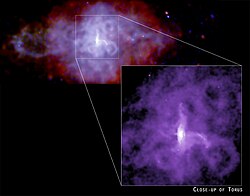3C 58
 X-ray image of 3C 58 by the Chandra X-Ray Observatory. The pullout box shows the inner toroidal-shaped nebula | |
| Observation data Epoch J2000.0 Equinox J2000.0 | |
|---|---|
| Constellation | Cassiopeia |
| Right ascension | 02h 05m 38s |
| Declination | +64° 49.7′ |
| Apparent magnitude (V) | 8.17 |
| Characteristics | |
| Spectral type | III[1] |
| Astrometry | |
| Distance | 10,000 ly (3067.48 pc) |
| Absolute magnitude (MV) | 3.70 |
| Details | |
| Mass | 1.36–1.52[1] M☉ |
| Temperature | 150,000[1] K |
| Rotation | 65.7159285 ms |
| Age | 840? years |
| Other designations | |
| Database references | |
| SIMBAD | data |
3C 58 or 3C58 is a pulsar (designation PSR J0205+6449) and supernova remnant (pulsar wind nebula) within the Milky Way that is possibly associated with the supernova of 1181. There are, however, signs that indicate that it could be several thousand years old, and thus not associated with that supernova.[2] The object is listed as No. 58 in the Third Cambridge Catalogue of Radio Sources.
The pulsar is notable for its very high rate of cooling, which is unexplained by standard theories of neutron star formation. It is hypothesized that extreme conditions in the star's interior cause a high neutrino flux, which carries away the energy so that the star cools.[3][1] 3C 58 has been proposed as a possible quark star.[4][5]
It is located 2° northeast of ε Cassiopeiae and is estimated to be 10,000 light-years away. Its rotation period is 65.7 ms (so PSR J0205+6449 does not belong to the class of millisecond pulsars).
References[]
- ^ a b c d e Yakovlev, D. G.; Kaminker, A. D.; Haensel, P.; Gnedin, O. Y. (2002). "The cooling neutron star in 3C 58". Astronomy & Astrophysics. 389: L24–L27. arXiv:astro-ph/0204233. Bibcode:2002A&A...389L..24Y. doi:10.1051/0004-6361:20020699. S2CID 6247160.
- ^ Bietenholz, M. F. (1 July 2006). "Radio Images of 3C 58: Expansion and Motion of Its Wisp". The Astrophysical Journal. 645 (2): 1180–1187. arXiv:astro-ph/0603197. Bibcode:2006ApJ...645.1180B. doi:10.1086/504584. ISSN 0004-637X. S2CID 16820726.
- ^ "Chandra :: Photo Album :: 3C58". Chandra.harvard.edu. 14 December 2004. Retrieved 21 August 2012.
- ^ Cramer, John G. (November 2002). "Quark Stars". Analog Science Fiction & Fact Magazine. Retrieved 17 August 2015.
- ^ "RX J1856.5-3754 (and the 3C58 Pulsar)". www.solstation.com. Retrieved 18 August 2015.
External links[]
 Media related to 3C 58 at Wikimedia Commons
Media related to 3C 58 at Wikimedia Commons- Article about 3C58
- What is known about 3C 58
- Image from Aladin
Coordinates: ![]() 02h 05m 38.29s, +64° 49′ 44.4″
02h 05m 38.29s, +64° 49′ 44.4″
- Quark stars
- Pulsars
- 3C objects
- Cassiopeia (constellation)
- Variable star stubs